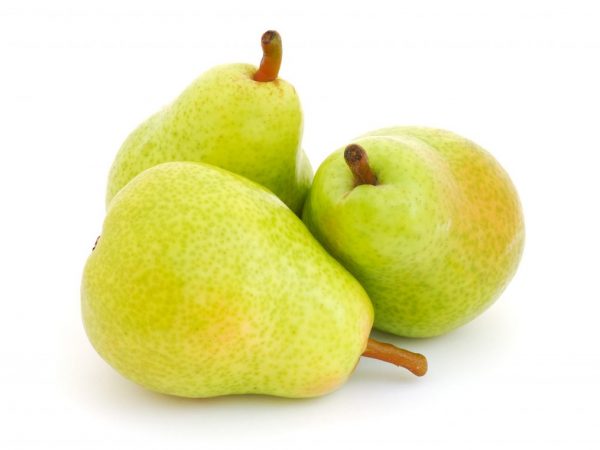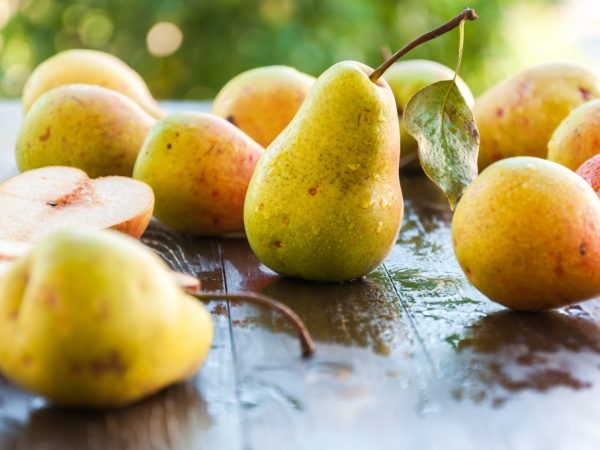Description of pear Larinskaya
If you want to grow high-quality products with a long shelf life, then the Larinskaya winter pear is ideal for you. The description notes that the variety is ideal for cultivation in the North Ural part of the country.

Description of pear Larinskaya
general information
The Larinskaya pear variety was bred in the Urals in the early 90s. This species was obtained after 2 other species were crossed: Ussuriiskaya and Lyubimitsa Klappa. Included in the State Register of the Russian Federation. The yield of the variety is excellent: about 40-60 kg of products are harvested from 1 tree.
Description of the tree
The tree of this variety is rather large, reaches a height of 7 m. The crown is cylindrical, rounded. The branches are located at an angle of 90 ° in relation to the main stem. Large dark green leaves. Flowering occurs with white inflorescences, which are characterized by a pleasant aroma. The tree begins to bear fruit 4 years after planting in a permanent place. It is considered self-fertile, therefore it does not need additional pollinators.
Description of the fetus
- during the ripening of the fruit, the peel is green, after 2 weeks of storage, the shade changes to yellow;
- round, slightly elongated;
- the average weight is 150 g;
- the seeds are brown, small;
Taste and use
Larinskaya pears belong to dessert cultures. It has a pleasant sweet taste, somewhat reminiscent of a peach. The pulp is juicy, not cloying. There is an improvement in taste during long-term storage.
You can eat the product fresh, use it to create fruit salads. High taste indicators are noted when preserved for the winter. Often used to prepare baby food.
Planting pear Larinskaya
It is necessary to plant the plant in early March. You need to decide on the right place to land. Plant the crop only in well-lit areas that are not near fences or buildings. Otherwise, the crown of the tree will not be sufficiently developed, which will negatively affect the final yield. The soil should be fertile, with a low acid-base balance (no more than 4%). The seedling must be at least 2 years old. It is believed that such planting material is more resistant to negative environmental factors and will allow you to get better yields. Make sure that the seedlings are free of damage or disease, otherwise the plant may die.
Literally 14 days before planting, you need to dig a hole and pour 1 bucket of humus or compost into it. This will allow the soil to be saturated with beneficial ingredients. As soon as the planting day comes, you need to put the seedling in the hole so that the root collar is above the ground (literally 4-6 cm). The roots are carefully distributed throughout the pit, covered with earth, and the soil is compacted. You need to drive in a metal peg next to it to tie up the bush, otherwise it may deform in strong winds. Usually, no more than 2 plants are planted per 1 square meter due to their large crown.
Plant care

The pear does not need abundant watering
Larinskaya pear variety is unpretentious in care. You don't need to water the plant often. It is enough to pour in about 10-15 liters of warm water once a week. Watering is carried out early in the morning or late in the evening to avoid moisture evaporation. After watering, it is advisable to loosen the soil to a depth of 10 cm. It is necessary to remove weeds, since they take too much nutrients from the soil.
Fertilizers are applied as the plant develops. The first feeding using superphosphate (30 g per 10 l of water) is carried out 1 month before flowering. 5 liters of the drug are poured under the plant. With the beginning of fruiting, you need to dilute 50 g of potassium nitrate in 10 liters of water and pour 5 liters under each bush.
Pruning of branches is carried out annually, 2 times. The first pruning is done in early March. At this time, you need to remove dry branches. In the fall, all damaged and diseased branches are cut off.
Pests and diseases
This species is resistant to powdery mildew, bacteriosis, scab and beetles. The main enemies of the plant can be the moth and aphid.
You can get rid of the moth by spraying with Bordeaux liquid (2 mg per 10 liters of water). In the fight against aphids, it is advisable to use a solution from Oxychom (40 mg per 10 liters of water).
Conclusion
The larin pear is considered an excellent option for beginners in the field of gardening. It is unpretentious in care, resistant to diseases and has excellent yield indicators, so the demand for it is growing every year.


